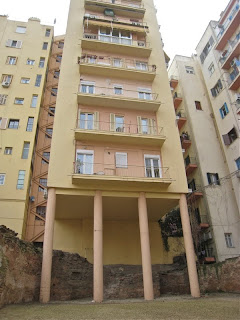Some time back, a couple from Texas, who were planning a trip to Thessaloniki and northern Greece, came across an informational website I help out with, and wrote me to ask if I would help them get around northern Greece so that they could see the places the Apostle Paul went.
I spent four days this past week going around with them and here are a few photos from our travels. Above is a shot of the remains of what seems to be an important administrative center in the city around 200 BC, during the time of Philip V's reign as King of Macedonia.
We also stopped by Galerius' palace complex (ca. 300 AD) in the heart of Thessaloniki. Above is a photo taken from the entrance of the Octagon, which was probably a throne room. The apse, directly across from the entrance, was probably where the imperial throne would have been situated. Suppliants would then make the long walk across this enormous room in order to approach the emperor. This room was turned into a church later in the fourth century and the apse, naturally, was used as the altar area.
It seems that this kind of apse, opposite the entrance, was standard in reception rooms, including those in the homes of the wealthy (although, obviously, much smaller than this one). This is one reason it is speculated that Christians in the first century may have met in these receptions rooms (triclinium) of the wealthy members of the community.
As always, the ancient ruins never prevented the city from continuing to live. Here is one of the buildings next to the ruins of Galerius' palace, built over some walls.
Here is a photo from inside the Rotunda, part of Galerius' enormous palace complex. It was probably intended as a mausoleum for Galerius, but he was never interred here. The Christians also turned this into a church later in the 4th century. While we were in there, one of the city's stray dogs came in and climbed up the scaffolding to the very top. You can make out his eyes if you look carefully. He was interested in hunting down one of the city's stray cats who was also up there. The scaffolding is up so that workers can try to restore the building's mosaics.
On Wednesday, we went to visit the Royal Macedonian Tombs at Vergina. We then went over to Beroia (Veria) to see the bema (steps/pulpit) from which St. Paul preached. Sts. Paul and Silas went to Veria after being chased out of Thessaloniki. See Acts 17:10-15 (RSV): [10] The brethren immediately sent Paul and Silas away by night to Beroe'a; and when they arrived they went into the Jewish synagogue. [11] Now these Jews were more noble than those in Thessaloni'ca, for they received the word with all eagerness, examining the scriptures daily to see if these things were so. [12] Many of them therefore believed, with not a few Greek women of high standing as well as men. [13] But when the Jews of Thessaloni'ca learned that the word of God was proclaimed by Paul at Beroe'a also, they came there too, stirring up and inciting the crowds. [14] Then the brethren immediately sent Paul off on his way to the sea, but Silas and Timothy remained there. [15] Those who conducted Paul brought him as far as Athens; and receiving a command for Silas and Timothy to come to him as soon as possible, they departed.
The mosaics above and below are on either side of the bema from which St. Paul preached. Above is a depiction of the man of Macedonia appearing to St. Paul while he was in Asia Minor and imploring him to come to Macedonia (see Acts 16:9). Below is a depiction of St. Paul preaching to the Jews of Veria, who examined the Scriptures "to see if these things were so" (see 17:11 above).
And here I am, standing on the bema where St. Paul preached. Below is a shot of the whole monument. It's quite sad and ironic that you can see a minaret just behind this monument commemorating the spot where St. Paul brought Christianity.
On Wednesday night, after our touring for the day, I was invited to a presentation of a new book that I translated. It's a dual-language (Greek/English) pilgrim's guide to the religious sites of the Metropolis of Ierissos and the Holy Mountain, which is located in the eastern part of Halkidiki. The book presentation was hosted by the local Thessaloniki club of people from Halkidiki, and it featured the Metropolis' protosyngelos (chancellor), who authored the book. He gave a presentation, with photographs, of some of the religious sites and history of the area. Fr. Chrysostomos is a monk of New Skete on Mt. Athos and, in addition to this duties as protosyngelos, travels frequently to the Congo where he teaches theology at the missionary school there.










No comments:
Post a Comment